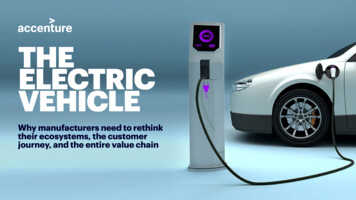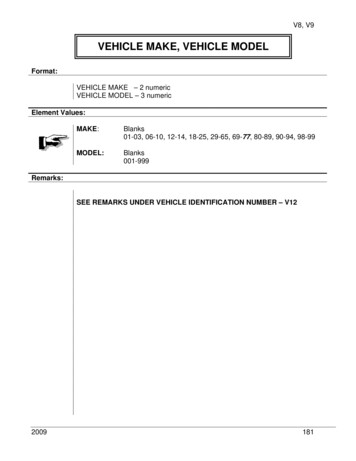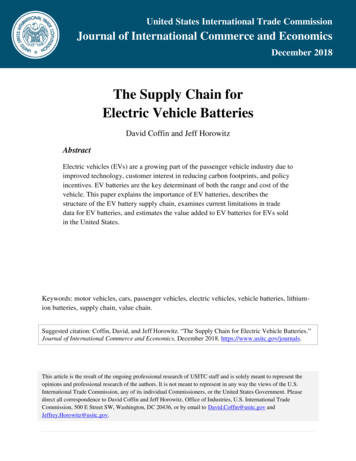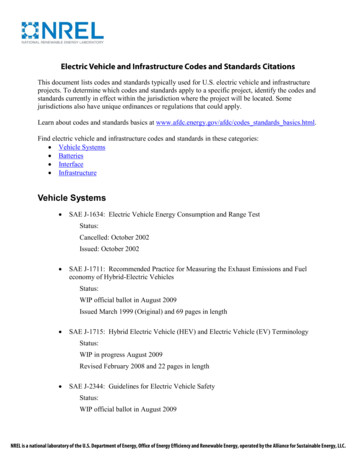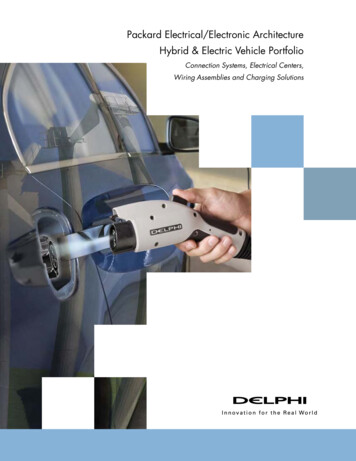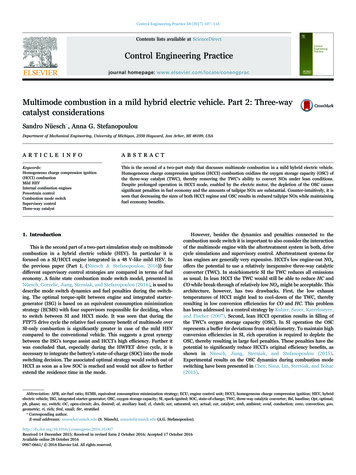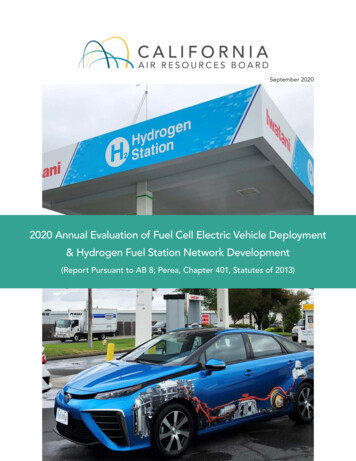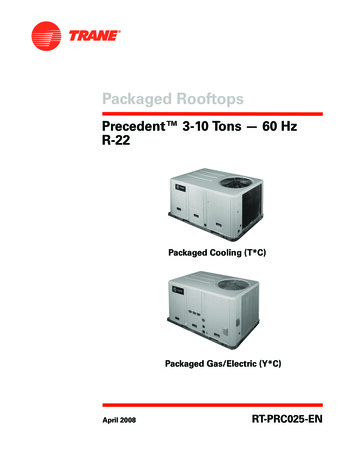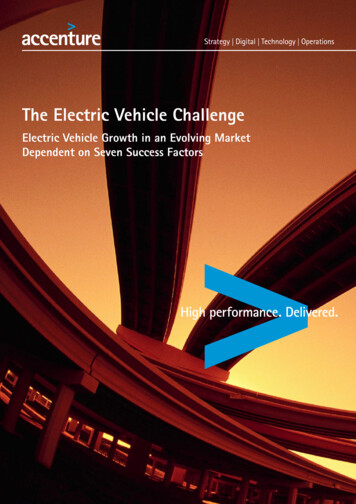
Transcription
The Electric Vehicle ChallengeElectric Vehicle Growth in an Evolving MarketDependent on Seven Success Factors
As the automotive industry moves through thesecond decade of the 21st century, uncertaintyover whether or not electric vehicles (EVs) willbecome a key part of the mainstream globalcar-buying market remains largely unchanged.The question of long-term viability has taken a backseat to a more immediate and pressing questionfor automotive original equipment manufacturers(OEMs) – what approach is needed to succeedin today’s EV market? The answer is not withoutchallenges. Unlike traditional vehicles, EVs require adifferent value chain and processes to support them.Moreover, consumer perceptions of the practicality,functionality, and the potential advantages ofEVs remain largely mixed in such areas as cost,savings, convenience, travel range, and charginginfrastructure. To succeed in the current businessenvironment, OEMs will need to adopt new strategiesto realize the full potential of the evolving eMobilitymarket. One important factor will be integrating andcollaborating with a group of diverse players, such asutilities, charging infrastructure owners, and mobilityproviders in a new mobility ecosphere.To succeed in today’s EV market OEMs have to facevarious challenges as mentioned above. Therefore,Accenture has identified seven success factors for theeMobility market that will ensure its long-term viability:2A. Government Regulationsand SubsidiesB. Integration of Electric Vehicleswithin the Product Portfoliosof OEMsC. Collaboration withinthe eMobility Value ChainD. Relevant Charging InfrastructureE. Reduction of CustomerAnxiety and Marketing ofeMobility BenefitsF. eMobility as anInnovation LeaderG. Adjustment of CoreOperations and Processes
3
A. GovernmentRegulationsand SubsidiesDriving the focus on EVs are evertightening CO2 emissions regulations and the investment ofbillions in subsidies and incentives by governments around theworld, encouraging greater industry participation and adoptionin the marketplace. In 2020, CO2 emissions will be regulatorylimited at 95 g/km as an average value throughout the vehiclefleet. In order to outbalance the CO2 performance of cars withhigher emission values, OEMs need to have zero-emissionvehicles like the EV. The U.S. Government recently invested 5 billion in electric cars, including loans and grants toautomakers and battery producers, spending on chargingstations, and 7,500 tax credits to car buyers with the goal ofhaving one million EVs on U.S. roads by 2015.1 In addition, moreand more global cities will become networked, integrated andbranded smart cities, where electric vehicles2 can be ideallydeployed in order to offer a better, cleaner urban mobilityexperience and help balance future smart electricity grids.Table 1: Overview of Global Tax Subsidies, August 2014; Source: AccentureTax ReductionCountryAustriaBelgiumExempt of car taxReduced annual circulation tax, no registration taxChinaSubsidies of 9.900 for PEVCzechNo road tax (business vehicles only)DenmarkExempt from registration taxFinlandReduced registration taxFrancen/a (only sales bonus)GermanyExempt from annual circulation taxGreeceExempt from registration taxIrelandExempt from registration taxItalyJapann/a (only sales bonus)Subsidies pp to 8.500 for PEV; Additionally taxexemption of automobile acquisition & automobileweight taxLuxembourgn/a (only sales bonus)NetherlandsExempt from private motor vehicle tax,registration tax and annual circulation taxNorwayNo VAT and registration taxPortugalExempt of registration tax and annual circulation taxRussiaSpainSwedenSwissUKUSA4B. Integration ofElectric Vehicleswithin the ProductPortfolios of OEMsFor the first time a range of EV and hybrid models are on ourroads, signaling that eMobility, the electrification of the vehicle,has begun in earnest. The auto sector, in its inaugural stage ofelectric vehicle manufacturing on a broad scale, is close to thepoint where every major marquee is producing at least one EVmodel. Today, the universe of available EV drivetrains includesbattery electric vehicles (BEVs); plug-in electric vehicles (PEVs),plug-in hybrid electric vehicles (PHEVs); and BEVs with rangeextender (E-REVs) capabilities.While 2011 showed only a handful of EVs being manufactured, in2014 production is widespread, as new models are introduced.EVs are projected to become 10 to 15 percent of the global automarket by 2020 from a current base of ca. 0.2 percent.3 Whileadding a minimum of one EV to vehicle product lines will helpOEMs’ momentum in the marketplace, producing an EV modelseries like Volkswagen and Toyota will significantly increasemarket presence and perhaps generate better opportunities forsustained EV growth.In Europe, the market share of EVs including BEVs, PHEVs, andE-REVs, is expected to represent the lion’s share of the marketby 2040 in terms of drive technologies compared to internalcombustion engines (ICE), fuel cells, and other alternative fuels.4Plug-in electric vehicles (PEVs) continue to gain in popularity invarious regions, such as North America. PEV sales are forecastto reach 400,073 annual sales in the U.S. market and 107,146 inCanada by 2020.5Furthermore, increased EV sales will set the stage for asignificant eMobility-related growth market in the comingyears. Global eMobility is expected to create an estimated 390 billion market by 2020.6 New electric vehicles andcomponent production, innovative financing models, charginginfrastructure stations, green power-generation businesses,eMobility providers, battery producers, energy suppliers anddistributors will be key growth drivers. Contributing to thismarket will be OEMs like General Motors (GM) that plans tobuild up to 500,000 electric-technology vehicles annually by2017. This includes the Chevrolet Volt plug-in hybrid. GM hasmade rolling out cars with electric technology, including itseAssist system, part of its global strategy.7Tax exemption for 2 yearsRegional car tax reductionsExempt of registration taxRegional car tax reductionsn/a (only sales bonus)State rebates from 1000- 6000,additionally federal tax credit up to 75004
The BMW i3 and i8In an industry that is affected by changing customer needs,new technologies and upcoming regulation, the whole autosector is perpetually setting the focus on the development ofalternative engine technologies and concepts, seeking answersfor the challenges that come along with eMobility. The OriginalEquipment Manufacturers (OEMs) differ, however, regardingthe technologies they develop as well as the extent to whichthey realize eMobility concepts. With the new sub brand BMW i,BMW aims to meet the new challenges in a very holistic andsustainable way.Whereas other OEMs are following a step-by-step approachimplementing electric drive in already existing vehicles of theirfleets, BMW i rethought many aspects like design or materialswhen developing completely new cars. In 2007, the “Project i”started with a team consisting of only a handful of people.8 Sixyears later and after an investment of approximately 2 billionEuro, the BMW i3 was introduced in November 2013 as thefirst battery electric vehicle under the BMW i brand.9 BMWis producing one hundred i3s per day and aims to sell 10,000vehicles in 2014.10 The BMW i3’s maximum electric range is atPhotos: BMW Group160 km (mean customer value) but can be extended through theintegration of a conventional engine, the Range Extender. Themaximum speed of the zero-emission vehicle is limited at 150km/h. Using a conventional power point, the car’s battery canbe charged within 6-8 hours whereas less than 30 minutes areneeded when charging at fast charging stations.11The auto body of the BMW i3 consists of carbon, an expensivematerial which is about five times lighter than steel. This goesalong with better performance regarding aerodynamics andenergy consumption. The ecological approach is also proven in theinterior of the vehicle where only materials of sustainable sourcesare used, for example the textiles on the seats which are createdfrom up to 100 percent recycled fibers.12Whereas the BMW i3 (from 34,950 )13 is aimed at a wideaudience, the BMW i8 (from 126,000 )14 addresses the luxurycustomer segment. The sports car, introduced in the summer of2014, is a plug-in hybrid electric vehicle, providing an electricengine for the front axle as well as a conventional three-cylindergasoline engine powering the rear axle. Using both power sources,the i8 accelerates from 0-100 km/h in 4.4 seconds.155
C. Collaborationwithin the eMobilityValue ChainThis first phase of electric vehicles inthe marketplace presents new challenges for OEMs in termsof executing an effective and sustained growth strategy. As adeparture from conventional automobiles, EVs are engaged inan eMobility ecosphere comprised of a wide range of playersthat, while not part of the sector, are critical to its success inthe EV space. They represent a new value chain with whichOEMs must collaborate and innovate to establish a viable,global eMobility market. The mentioned players includeutilities, charging location owners, charging infrastructureoperators, service providers, vehicle users, mobility providers,and financial services and leasing companies.To increase consumer acceptance of EVs, an interconnectedpartners’ ecosphere will need to be designed and organizedon many levels, including developing contracts, processesand exchanging data. Although integration platforms areemerging, they are not broadly established yet. Realizing thisinterconnectivity is crucial for ensuring the success of eMobility.Utilities, for example, may want to offer CO2-neutral energyproducts and integrated charging solutions, while charginglocation owners integrate charging offerings like a cooperativeparking business model. Investments in charging infrastructurethat result in profitable business models will be required.eMobility solutions will need to be simplified to increase theirappeal, and mobility providers can play a key role in EV marketgrowth through innovative mobility offerings.Customers may prefer to lease, rent, or share green vehiclesrather than purchase them. OEMs will need to determine howto differentiate themselves in the EV market in this regard,as well as through engine features, service for batteries, gridtechnologies, or mobile services. To make car-sharing work,OEMs and their ecosphere partners will need to collaborateon the necessary infrastructure. Mobile crews may be betterin a given market for pickup and drop-off than fixed returnstations. OEMs will need to continue working with partnersthat may have more roadside assistance experience to developthe systems required to communicate to the service crew aproblem with a disabled EV on the road. Mobile connectionsto a central testing capability also will be necessary to overseethe performance of critical vehicle components. Finally, pricingand payment processes will need to be put in place to completethe transaction—another area that OEMs will need to explorethrough collaboration with appropriate ecosphere partners.6
7
D. RelevantChargingInfrastructureConvenient EV charging infrastructurewill be a key factor for a successful EV market. Currently, thereare two primary charging locations, at home or work. Bothsources involve legal challenges in terms of taxation, theft andaccounting that will need to be addressed. While OEMs areoffering home-charging solutions with customer EV purchases,and attempting to kickstart the charging market throughplatforms integration with other eMobility ecosphere partners, thelack of widespread public charging stations as of yet, continues toplace a greater focus on hybrid vehicles.Public and semi-public charging infrastructure is still uncertain,as large-scale investment has not yet surfaced to support semiand public-charging infrastructures as a standalone business.Currently, there are limited pilot projects, including cooperativeurban initiatives supported by city-government funding andinstalled by energy utilities, state-funded projects, and businesssupported efforts designed to show eMobility feasibility.Accenture research of PEV pilots reveals that, despiteexisting barriers to greater EV acceptance, drivers do changetheir perceptions toward PEVs once they are provided withinformation and hands-on experiences.16Table 2: Total Investments Of Public Charging Points In Germany;Source: Federal Ministry of Education and Research of Germany8Year2011201220132014Total stockof ntin Mio.Euros(rounded)78.58.512
Connected Electric Vehicles - Supporting Infrastructure FunctionsConnectivity as a module of infrastructure represents an essential prerequisite in electric vehicles andplug-in hybrids to help alleviate range anxiety. Essential connected vehicle features support the anxiety ofan accessible infrastructure and will affect future EV adoption.Vehicle range control:New infrastructure (charging stations) and real-time information about availability, having the ability toreserve charging stations on the move and payment methods would be useful for the success of electric cars.Locate charging station:The range anxiety issue could be solved using a GPS and web-based system to locate charging stations.The Nissan LEAF’s in-vehicle digital system called EV-IT uses communication networks and a dashboardto keep the driver constantly updated about the range of the vehicle and the closest charge point.17Recharging costs information and payment:Connectivity could allow data communication with the electricity providers in order to receive costsinformation and payments in real-time.Monitor and manage battery charging online:Battery charging could be controlled using a mobile phone or a computer and provide interaction with a smartcharging system. The BMW i Remote App for iOS and Android shows detailed information on the current statusof BMW i
operators, service providers, vehicle users, mobility providers, and financial services and leasing companies. To increase consumer acceptance of EVs, an interconnected partners’ ecosphere will need to be designed and organized on many levels, including developing contracts, processes and exchanging data. Although integration platforms are
